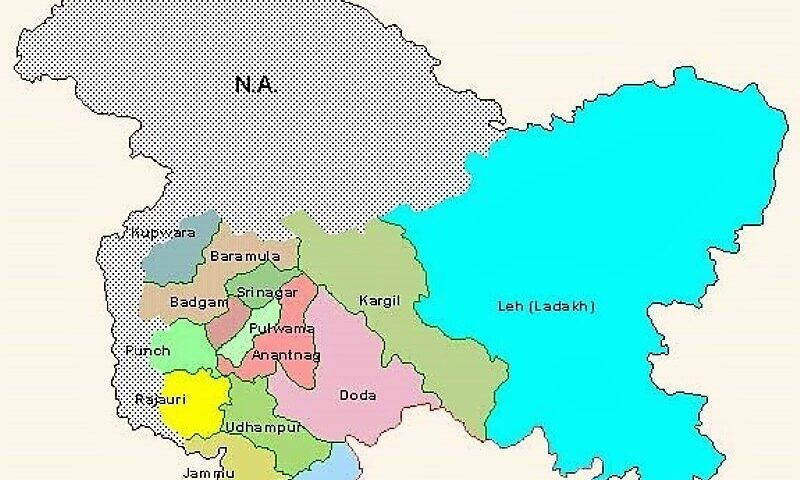Alert in J&K: Red‑Level Flash Flood & Landslide Warning Active Through July 9
By: Javid Amin | Srinagar | 06 July 2025
The Meteorological Department of Jammu & Kashmir (J&K MeT) has issued a red alert for flash floods, landslides, mudslides, and associated hazards across vulnerable parts of the Union Territory. The advisory is in effect from today, July 6, through July 9, urging residents, travelers, farmers, and officials to stay vigilant.
What the Alert Says
-
Flash Flood Threat: Heavy downpours are forecasted in both low-lying plains and mountainous terrain. Swiftly rising water in rivers, streams, and local “nalas” (mountain streams) could inundate inhabited areas.
-
Landslide & Mudslide Risk: Saturated slopes in hilly districts may give way, triggering landslides and rockfalls along highways and rural roads—creating hazards particularly overnight and at dawn.
-
Shooting Stones: Smaller rockslides in steep terrains pose a direct threat to passersby and vehicles.
-
Urban Waterlogging: Poor drainage in city lowlands can result in standing water, flooding roads, and disrupting daily life.
Rainfall Snapshot: June 5–6 (Past 24 Hours)
Recent rainfall figures highlight the intensity and distribution of this weather event:
| Location | Rainfall (mm) |
|---|---|
| Jammu | 93.2 |
| Katra | 85.8 |
| Rajouri | 64.5 |
| Udhampur | 38.0 |
Districts on High Alert
The following areas are most immediately at risk:
-
Doda
-
Kishtwar
-
Rajouri
-
Poonch
-
Udhampur
Local administrations in these districts have issued alerts, urging heightened preparedness—especially for road travel, mountain pathways, and vulnerable neighborhoods.
What Residents Should Do
Farmers
-
Temporarily halt field operations, including harvesting and irrigation—standing water and muddy slopes pose serious risks.
-
Secure crops and equipment in sheltered storage to avoid loss from flooding.
-
Monitor official updates daily before resuming any activity.
Travelers & Pilgrims
-
Exercise extreme caution on hilly roads, especially at night and early morning.
-
Adhere to guidance for the Amarnath Yatra, including route closures and sliproad warnings.
-
Stay updated with travel advisories issued by authorities and local law enforcement.
Urban Dwellers
-
Avoid venturing into low-lying areas prone to urban flooding.
-
Drive carefully: even a few centimeters of water can stall vehicles.
-
Prepare emergency kits in case of sudden floods or power interruptions.
Expert Insight
A senior meteorologist from the J&K MeT shared:
“The monsoon’s onset in these parts often leads to concentrated, heavy rain episodes, particularly in the western Himalayan foothills. When the soil is saturated, even moderate showers can trigger landslides and flash flooding.”
They emphasized that overnight and early morning hours are notably critical, as moisture-rich air accumulates in valleys and high plateaus.
Broader Context & Historical Perspective
-
Late June Forecast: Widespread rain and thunderstorms have already lashed many parts of J&K. Areas such as Doda, Ramban, and Poonch saw moderate to heavy rainfall even before this latest event youtube.com+4greaterkashmir.com+4thestatesman.com+4.
-
April 2025 Incident: A severe flash flood and landslide in Ramban district—triggered by a cloudburst—claimed three lives, over 100 were rescued, and multiple homes and a national highway section were damaged financialexpress.com+2indiatoday.in+2hindustantimes.com+2. These recent events underscore local vulnerability to sudden, intense weather.
-
Previous flash floods in July 2023 led to red alerts and triggered evacuations along the Jhelum River, with emergency responses increasing amid rising water levels thestatesman.com+1lokmattimes.com+1.
These patterns reflect a concerning trend: monsoon intensification in the Himalayas—leading to more frequent flash hazards.
Safety Measures & Precautions
-
Monitoring and Updates
-
Subscribe to MeT alerts via SMS/WhatsApp.
-
Tune into radio, TV, and local government bulletins regularly.
-
Follow verified X/Twitter channels of J&K administration and Disaster Management Centers.
-
-
Preparedness at Home
-
Secure rooftops and drains.
-
Store essentials like water, medications, and non-perishables in elevated, accessible places.
-
Identify safe shelters in your locality designated for flood or landslide evacuation.
-
-
During Travel
-
Pre-plan routes—especially for the Amarnath Yatra.
-
Travel only during daylight.
-
Adhere strictly to road closures or detour orders from police or tourism departments.
-
-
In Case of Sudden Events
-
Evacuate immediately if you notice rising water or cracking sounds in slopes.
-
Do not try to cross fast-flowing water; even ankle-high currents can sweep vehicles.
-
Keep communication devices charged and inform family or rescue services of your location.
-
-
Post-Rain Vigilance
-
Avoid reentry into damaged or flooded areas until officials declare them safe.
-
Report new cracks, slippage, or blocked drains to local authorities.
-
Reach out for mental health support—these crises can cause emotional strain.
-
Forecast & Outlook
-
July 7–9: Continued heavy to very heavy precipitation. Most intense activity expected overnight and in the early morning.
-
Post-July 9: Upper-level weather systems may ease monsoon activity, but scattered thunderstorms could persist—especially in southeastern districts.
Local agricultural officials have announced crop protection initiatives, deploying machinery and labor to reinforce breached embankments in critical agricultural zones.
Government & Community Initiatives
-
District administrations in high-risk areas are:
-
Activating Disaster Response Teams (DRTs)
-
Mobilizing NDRF and SDRF units
-
Coordinating with local police and municipal services for proactive evacuation plans.
-
-
Public awareness campaigns: Pamphlets and audio notices are being circulated in remote villages to educate on risk signs and ensure swift response.
-
Engineering prep: Inspecting bridges, slope supports, culverts, and drainage systems ahead of the heavy flashflood window.
-
Funding readiness: Provincial relief funds have been earmarked to facilitate immediate aid—temporary shelter, medical services, and infrastructure restoration.
Tech & Innovation in Disaster Management
J&K has started leveraging:
-
Real-time satellite mapping for rainfall and cloudcover.
-
Early-warning sensors near landslide-prone slopes.
-
Networked portable water-level monitors on feeder streams.
-
Drone assessments to quickly survey damage post-event.
These systems aid authorities in rapid risk evaluation and resource deployment, minimizing both loss and response delays.
Environmental & Climate Linkages
-
Climate change is intensifying regional water cycles: warmer air holds more moisture, leading to flashier monsoon patterns.
-
Himalayan deglaciation exacerbates soil instability, with thawing cycles weakening slopes.
-
Deforestation and unplanned development contribute to reduced natural water absorption, increasing runoff and landslide susceptibility.
-
Urgent need: Sustainable, nature-based solutions like reforestation, slope terracing with native vegetation, and improved watershed management.
Voices from the Ground
A Ramban farmer recently impacted by April’s flash flood shared:
“The water came in minutes; we barely had time to save crops. Now, every rain brings fear.”
An Amarnath yatra pilgrim commented:
“We’re alert. Officials reassured us, but being in the hills overnight when it’s raining heavily is nerve-wracking.”
These reflections echo widespread community anxiety—underscoring the need for preparedness and clear communication.
Key Dates to Watch
-
July 6–9: Red-alert window. Highest danger of flash floods and landslides.
-
July 10 onward: Possible easing—but vigilance remains essential due to residual weather volatility.
What You Can Do – At a Glance
-
Stay informed: official channels only.
-
Avoid risky travel: especially at night or in hilly terrain.
-
Prepare your home and family: kits, plans, evacuation routes.
-
Follow advisories: “go-right-away” when evacuation is advised.
-
Document damage: for insurance and aid requests later.




